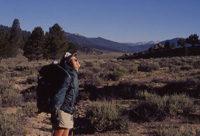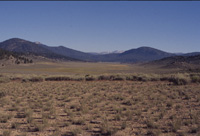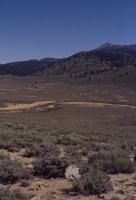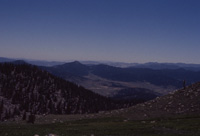
Amy unthaws in the morning
sun. Mmmmmm......

The vast Monanche Meadows.
(Boy, I'm good with these captions.)

Gold, gold in the American
River? No, I'm sorry. It's
cows, cows, in the upper
Kern. (You have to make the
picture larger to see them
so keep it this size and it's
just a nice picture of a
meadow.

Hey, that looks like the vast
Monanche Meadows again! It
sure is, only this time it's
from the shoulder of Olancha
Peak.
Finally, we saw an area upon the hillside that was being warmed by the sun and made a run for it. for it. We stood, arms and legs spread apart and faces upturned and wonderfully, within minutes, warmth seeped into our shivering bodies.
We hiked on, spirits restored and soon entered an enormous meadow area called Monanche Meadows. (I tried to pronounce it in some snobby foreign way through my nose, but it is pronounced like Comanche) These meadows are the largest in the entire Sierra Nevada. The headwaters of the Kern River are not far away and it flows through the meadow.
It was then we saw a wonderful and rare sight! Wild cows were grazing in these lush meadows, probably the descendants of those lost by Spanish explorers hundreds of years ago. It sure is wonderful to know that there are some places in California where these beautiful beasts can roam, undisurbed by man. Thrilled to bits, we photographed them defecating upstream from the place where we planned to pump water.
Now that we have escaped the heat of the desert, a question remains: will we ever escape the cows?
We departed the area and climbed the slopes of majestic Olancha Peak. From the top of Mt. Baden-Powell, we could see Telescope Peak and Olancha Peak and later, from the Mojave area onward, we had gazed at this mountain, first seeing it just as a small point of dark blue and then larger and larger until today when we stood on its slopes. We climbed to its shoulder, 10,500 feet, reaching the highest elevation the trail so far. The view was spectacular. We retraced our steps once again as we gazed to the south. (mentally that is, NOT physically.)
While hiking north down the mountain, we ran into another backpacker heading south to Kennedy Meadows. We exchanged the all-important information regarding water sources and the moved on to other more interesting topics. She, Nora, (I hope that's the right name) had information on the hikers we who were now just ahead of us. She had an interesting story about the three hikers with the poison oak from a couple of days ago. She and her husband hike sections of the PCT and earlier in the spring, they had met these same three hikers in the San Bernardino Mountains and had given them extra food and water when they had run out. The hikers were extremely grateful and that was the last she had seen of them. Now, here she was in an entirely different area, and who does she run across but the same three hikers again in dire need of assistance. Apparently, the poison oak was not getting better and she (who is a doctor) wrote them out prescriptions for medication that they could fill in Lone Pine. She was pretty surprised to see them and vice versa. We all hope they make it to Canada-sounds like they are hanging in there and have great spirit. Maybe we will meet them up the trail. Nora was a neat lady. We both liked her a lot and it would have been nice to spend more time talking with her.
After leaving her, we hiked down the mountain to Death Canyon where we bravely decided to camp despite the somber name. We tried to imagine the origin of the name while gazing up at the steep canyon walls. "Maybe it's because no undergrowth can grow beneath the thick forest," Scott said. (Yeah, right-but it sounded good as dusk settled in and we went to sleep.) [I had a theory about a one-armed axe murderer with a hook for a hand, but Amy liked that one even less -Scott]